BIODIVERSITY INVENTORY IN AND AROUND TENKA YEKKARU GRAMA PANCHAYAT, MANGALORE TALUK, DAKSHINA KANNADA DISTRICT, KARNATAKA.
BIODIVERSITY INVENTORY IN AND AROUND TENKA YEKKARU GRAMA PANCHAYAT, MANGALORE TALUK, DAKSHINA KANNADA DISTRICT, KARNATAKA.
 |
|
In response to a letter dated 7th November 2007, from the President, Yekkaru Grama Panchayat, Mangalore taluk, inventory and mapping of biodiversity was undertaken on 12-14th November 2007 in Permude, Tenka Yekkaru, Delanthabettu and Kuttethuru villages, to understand the ecological importance of the region considering its proximity to the Western Ghats, one of the eight hottest biodiversity hotspots of the world (http://ces.iisc.ernet.in/biodiversity). Opportunistic and all out search methods of flora and fauna were carried out for this study. Local residents were also consulted for mammal inventory, apart from our study. Aquatic and terrestrial ecosystems with various landscapes viz., wetlands, rivers, streams, paddy fields, forests, soppina betta (haadi), scrub jungle and sacred grooves were considered in this study.
Table 1: Sampling sites |
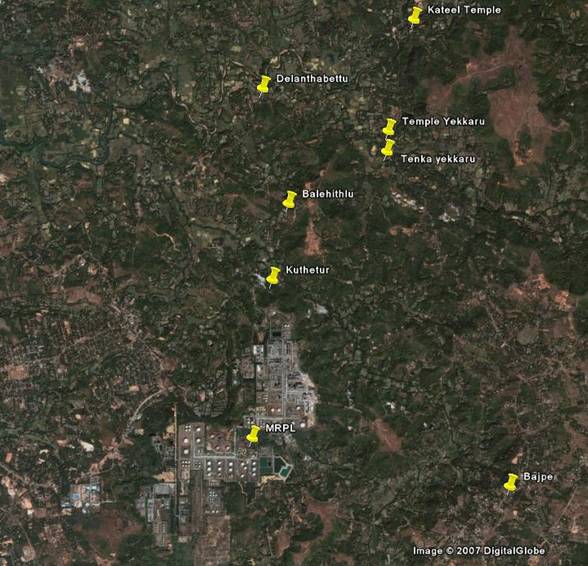 Figure 1: Google earth scene of the study locality |
Landscape elements are depicted in Figures 2, 3, 4 and 5 respectively.
|
|
|
|
|
Vegetation : All out search method was carried out in all landscape elements of the region enlisting grass, sedges, herbs, climbers, lianas, shrubs and trees. Species were identified on the spot. Table 2 lists 187 species observed during the survey. Table 3 lists 81 species of wetlands plants in the region. Figure 6 depicts a few flower plants of the region.
Table 2. Plant species recorded from selected localities
Abrus precatorius |
Caralia antegerima |
Euphorbia hirta |
Acacia auriculiformis |
Careya arborea |
Ficus asperima |
Acacia concinna |
Carissa carandas |
Ficus hispida |
Acacia mangium |
Caryota urens |
Ficus racemosa |
Acampe sp. |
Cassia alata |
Ficus religiosa |
Achyranthes aspera |
Cassia tora |
Flacourtia montana |
Adathoda vasica |
Casuarina equisetifolia |
Garcinia indica |
Ageratum conyzoides |
Chasalia curviflora |
Garcinia xanthochymus |
Aglaia eleginoides |
Chloris barbata |
Geissaspis cristata |
Alstonia scholaris |
Cinnamom malabaricum |
Gloriosa superba |
Alternanthera sessilis |
Clerodendron paniculatum |
Gliricidia maculata |
Anacardium occidentale |
Clerodendron viscosum |
Grewia microcosm |
Anamirta cocculus |
Colocasia esculentum |
Gymnostachium febrifugum |
Antidesma menasu |
Corchorus capsularis |
Hemidesmus indicus |
Aporosa lindleyana |
Costus speciosus |
Heteropogon contortus |
Aristida cetacea |
Chromolina odorata |
Hibiscus furcatus |
Artabotrys sp. |
Crotalaria juncea |
Holigarna arnottiana |
Artocarpus hirsutus |
Crotalaria labernifolia |
Hopea parviflora |
Artocarpus integrifolius |
Crotalaria leptostachya |
Hopea ponga |
Artocarpus lakoocha |
Crotalaria striata |
Hugonia mastax |
Atlantia racemosa |
Cryptolepis buchanani |
Hyptis suaveolens |
Aurundinella metzii |
Curculigo orchioides |
Ichnocarpus frutescens |
Arundinella purpurea |
Curcuma oligantha |
Ipomoea pentaphylla |
Bambusa arundinacea |
Cyclea peltata |
Ipomoea prescapre |
Borassus flabellifer |
Cyrtococcum oxyphyllum |
Ipomoea sp. |
Borreria hispida |
Cyrtococcum patens |
Ischaemum indicum |
Borreria stricta |
Dalbergia sympathetica |
Ixora brachiata |
Brachiaria milliformis |
Derris uliginosa |
Ixora coccinea |
Bridelia stipularis |
Desmodium triquetrum |
Justicia simplex |
Breynia rhamnoides |
Desmodium triflorum |
Lantana camara |
Bryophyllum pinnatum |
Diospyros embryopteris |
Leea indica |
Buchanania lanzan |
Dioscorea triphylla |
Leucas linifolia |
Caesalpinia mimosoides |
Duranta plumeri |
Ludwigia perennis |
Caesaria sp. |
Elephantopus scaber |
Macaranga peltata |
Calycopteris floribunda |
Ensettia superba |
Madhuca latifolia |
Calophyllum inophyllum |
Eragrostis unioloides |
Mammea suriga |
Canthium parviflora |
Eragrostis viscosa |
Mangifera indica |
Canthium sp. |
Ervatamia heyneana |
Merremia hastata |
Melastoma malabathricum |
Ricinus communis |
Terminalia bellirica |
Memecylon malabaricum |
Saccharum spontaneum |
Terminalia catappa |
Memecylon talbotii |
Santalum album |
Terminalia paniculata |
Memecylon umbellatum |
Sapium insigne |
Themeda tremula |
Michelia champaca |
Saraca asoka |
Toddalia asiatica |
Mimosa pudica |
Scleria lithosperma |
Tragia involucrate |
Mimusops elengi |
Sida acuta |
Triumfetta rhomboidea |
Naregamia alata |
Sida rhombifolia |
Tylophora asthmatica |
Ocimum canum |
Smilax zeylanica |
Urena sinuata |
Odina wodier |
Solanum torvum |
Uvaria narum |
Olea dioica |
Sophubia delphinifolia |
Vangueria spinosa |
Ophiorrhiza harrisiana |
Spilanthus acmella |
Vateria indica |
Oplismenus compositus |
Sphaeranthus americanus |
Vernonia cinerea |
Pandanus furcatus |
Spondias pinnata |
Vitex altissima |
Passiflora foetida |
Streblus asper |
Vitex negundo |
Pennisetum polystachyon |
Strychnos nuxvomica |
Wagatea spicata |
Phoenix sylvestre |
Symplocos racemosa |
Wattakaka volubilis |
Phyllanthus amarus |
Synedrella nodiflora |
Wrightia tinctoria |
Phyllanthus urinaria |
Syzygium caryophyllata |
Zanthoxylum ovalifolium |
Plumeria alba |
Syzygium cumini |
Zizyphus oenoplia |
Pothos scandens |
Tacca pinnatifida |
Zizyphus rugosa |
Psychotria flavida |
Tamarindus indica |
Zizyphus jujuba |
Randia dumetorum |
Tectona grandis |
Zornia diphylla |
Rauwolfia serpentina |
Urena lobata |
Zingiber zerumbett |
|
|
|
Table 3: Wetland plants of the region
Aeschenomene aspera |
Eleocharis retroflexa |
Microcarpaea minima |
Ageratum conizoides |
Eleocharis spiralis |
Murdannia nudiflora |
Alternantera sessilis |
Eragrostis unioloides |
Murdannia semiteres |
Ammannia baccifera |
Eriocaulon cinereum |
Nymphaea nouchali |
Arundinella leptochloa |
Eriocaulon cuspidatum |
Nymphoides hydrophylla |
Bergia capensis |
Eriocaulon richardianum |
Nymphoides indica |
Centella asiatica |
Eriocaulon sexangulare |
Nyphoides parviflora |
Colocasia esculenta |
Fimbristylis acuminata |
Oryza rufipogon |
Commelina diffusa |
Fimbristylis bisembellata |
Oryza sativa |
Corchorus capsularis |
Fimbristylis ferruginea |
Oryza sativa var.nivara |
Crinum viviparum |
Fimbristylis littoralis |
Pandanus fascicularis |
Crotalaria gorrensis |
Fimbristylis shoenoides |
Panicum repens |
Crotalaria retusa |
Fuirena ciliaris |
Paspalidium flavidum |
Cryptocoryne spiralis |
Fuirena umbellata |
paspalidium punctatum |
Cynodon dactylon |
Geissaspiscristata |
Paspalidum scrobiculatum |
Cyperus compressus |
Hydrolea zeylanica |
Pycreus flavidus |
Cyperus difformis |
Hygrophilla ringens |
Pycreus polystachyos |
Cyperus halpan |
Hygrophilla schulli |
Pyreus stramineus |
Cyperus pilosus |
Ipomoea fistulosa |
Rotala macrandra |
Cyperus tenuispicata |
Isachne miliacea |
Rotala rotundifolia |
Desmodium heterophllum |
Ischaemum indicum |
Shoenoplectus articulatus |
Desmodium triflorum |
Ischaemum mangaluricum |
Shoenoplectus subulatus |
Eclipta prostrata |
Lerrsia hexandra |
Smithia sensistiva |
Eleocharis acutangula |
Lindernia sp. |
Sphaeranthus africanus |
Eleocharis atropurpurea |
Lobelia alsinoides |
Sphenoclea zeylanica |
Eleocharis dulcis |
Ludwigia hyssopifolia |
Utricularia aurea |
Eleocharis geniculata |
Melochia corchorifolia |
Wisneria triandra |
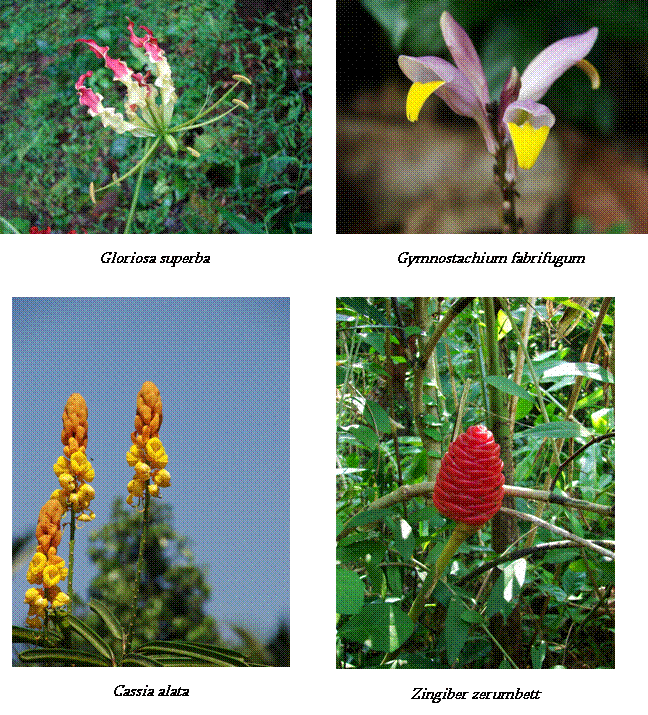
Figure 6: Diversity of flowering plants
Butterflies and Odonates: Different species of butterflies and dragon flies were recorded by all out search method in all landscape elements of the region. Table 4 lists 59 butterfly species from the region, of which two are endangered (Crimson Rose and Daniad Eggfly) and two are endemic (Malabar Raven and South Indian Blue Oak Leaf) to the Western Ghats. Eleven species of dragon and damselflies (odonates) were also recorded from the region (Table 5). Figure 7depicts a few odanates from the region.
Table 4. Butterfly species recorded with their ecological status. |
Table 5. Odonates species recorded from selected localities. |
||||||||||||||||||||||||||||||||||||||||||||||||||||||||||||||||||||||||||||||||||||||||||||||||||||||||||||||||||||||||||||||||||||||||||||||||||||||||||||||||||||||||||||||||||||||||||||||||||||||||||||
|
|
* Endemic to Western Ghats region
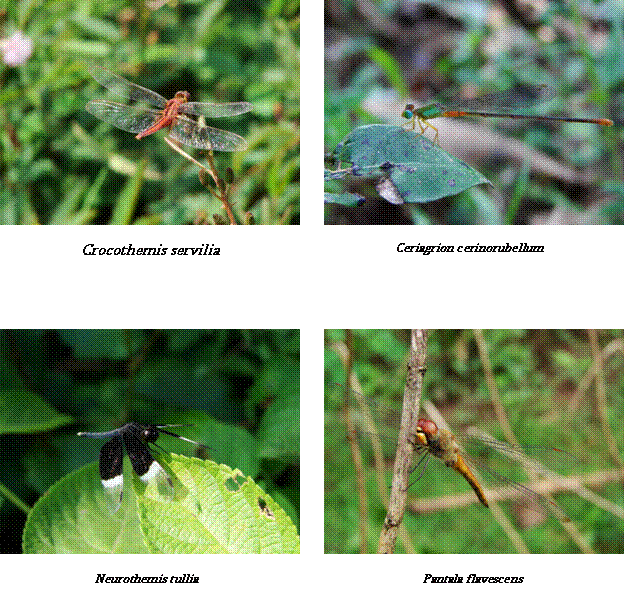
Figure 7: Glimpse of biodiversity - odonate species from the study region
Amphibians and Reptiles: Nocturnal searches were carried along streams and wetlands of the region for amphibians. Six species recorded are given in Table 6 and Figure 8. Among these, two are endemic to the Western ghats (Sylvirana aurantiaca and Philautus wynaadensis) and one endangered species (Philautus wynaadensis). Table 7 details three species of reptiles encountered during the study.
Table 6: Amphibians found in streams and wetlands near Tenka Yekkaru |
Table 7: Reptiles observed in the study area. |
||||||||||||||||||||||||||||||||||||||||||||||||
|
|
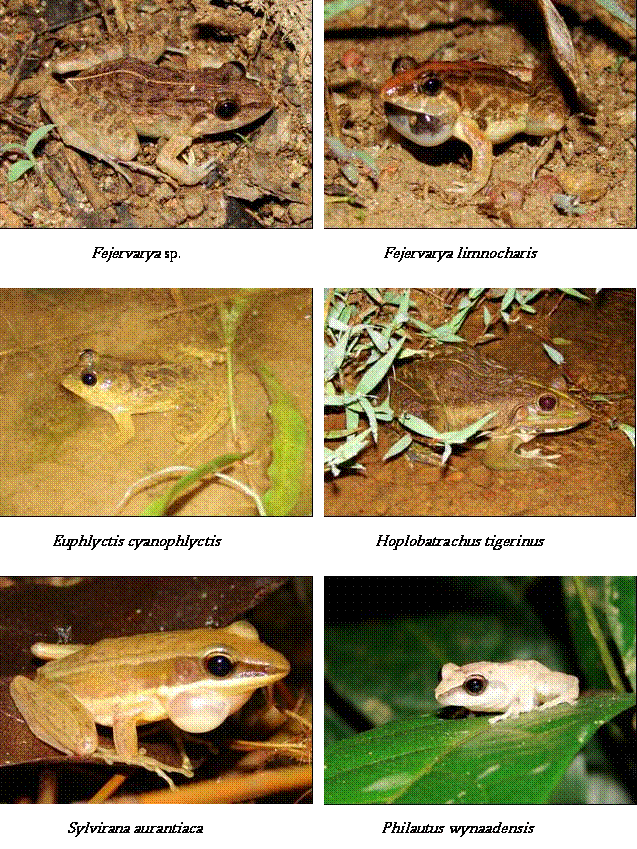
Figure 8. Amphibians recorded from the study region
Birds and Mammals : Hour count method in the morning hours was followed for bird sampling. Samplings were carried out in wetlands, paddy fields, scrub jungles, sacred grooves and forests. 55 species observed during the study are listed in Table 8 and Figure 9 depicts a few bird species recorded from the region. Indian peafowl is a Schedule I bird species. Seven species of mammals listed in Table 9 is based on opportunistic survey and interaction with knowledgeable residents of the region. Among these mammals, Gaur is Schedule I animal.
Table 8. Check list of birds recorded from the region
Common name |
Scientific name |
|
Ashy wood swallow |
Artamus fuscus |
|
Black-hooded oriole |
Oriolus xanthornus |
|
Black-headed munia |
Lonchura Malacca |
|
Rock pigeon |
Columba livia (Schedule IV) |
|
Golden-fronted leafbird |
Chloropsis aurifrons |
|
Common myna |
Acridotheres tristis |
|
Black drongo |
Dicrurus macrocercus |
|
Eurasian golden oriole |
Oriolus oriolus |
|
Brown shrike |
Lanius cristatus |
|
Greater coucal |
Centropus sinenis |
|
Grey wagtail |
Motacilla cinerea |
|
House crow |
Corvus splendens |
|
Indian robin |
Saxicoloides fulicata |
|
Jungle babbler |
Turdoides straitus |
|
Large-billed crow |
Corvus macrorhynchos |
|
Asian koel |
Eudynamys scolopacea |
|
Common flameback |
Dinopium javanense |
|
Little egret |
Egretta garzetta |
|
Little ringed plover |
Charadrius dubius |
|
Vernal hanging parrot |
Loriculus vernalis |
|
Intermediate egret |
Mesophoyx intermedia |
|
Asian paradise-flycatcher |
Terpsiphone paradise |
|
Black kite |
Milvus migrans |
|
White-browed wagtail |
Motacilla maderaspatensis |
|
Indian pond heron |
Ardeola grayii |
|
Purple-rumped sunbird |
Nectarinia zeylonica |
|
Purple sunbird |
Nectarinia asiatica |
|
Red-whiskered bulbul |
Pycnonotus jocosus |
|
Red-wattled lapwing |
Vanellus indicus |
|
Greater Racket-tailed drongo |
Dicrurus paradiseus |
|
Rose-ringed parakeet |
Psittacula krameri |
|
Scarlet minivet |
Pericrocotus flammeus |
|
Common kingfisher |
Alcedo atthis |
|
White-cheecked barbet |
Megalaima viridis |
|
Green bee-eater |
Merops orientalis |
|
Blue-tailed bee-eater |
Merops philippinus |
|
Spotted dove |
Streptopelia chinensis |
|
Scaly-breasted munia |
Lonchura punctulata |
|
Spotted owlet |
Athene brama |
|
Common tailorbird |
Orthotomus sutorius |
|
Thick-billed flowerpecker |
Dicaeum agile |
|
Rufous treepie |
Dendrocitta vegabunda |
|
White wagtail |
Motacilla alba |
|
White-throated kingfisher |
Halcyon smyrnesis |
|
White-breasted waterhen |
Amaurornis phoenicurus |
|
Wood sandpiper |
Tringa glareola |
|
Yellow wagtail |
Motacilla flava |
|
Marsh sandpiper |
Tringa stagnatilis |
|
Common redshank |
Tringa tetanus |
|
Baya weaver |
Ploceus philippinsis |
|
Red spurfowl |
Galloperdix spadicea |
|
Indian peafowl |
Pavo cristatus (Schedule I) |
|
Unidentified-leaf warbler |
||
Unidentified-Swallow |
|
|
Unidentified-Swifts |
|
|
Table 9: Mammals observed in the region.
Common name |
Scientific name |
WPA* 1972 |
Gaur |
Bos gaurus |
Schedule I |
Wild boar |
Sus scrofa |
Schedule III |
Indian Hare |
Lepus nigricolis |
Schedule IV |
Spotted deer |
Axis axis |
Schedule III |
Porcupine |
Hystrix indica |
Schedule IV |
Common mongoose |
Herpestes sp. |
Schedule II |
Flying squirrel |
Petaurista philippensis |
Schedule II |
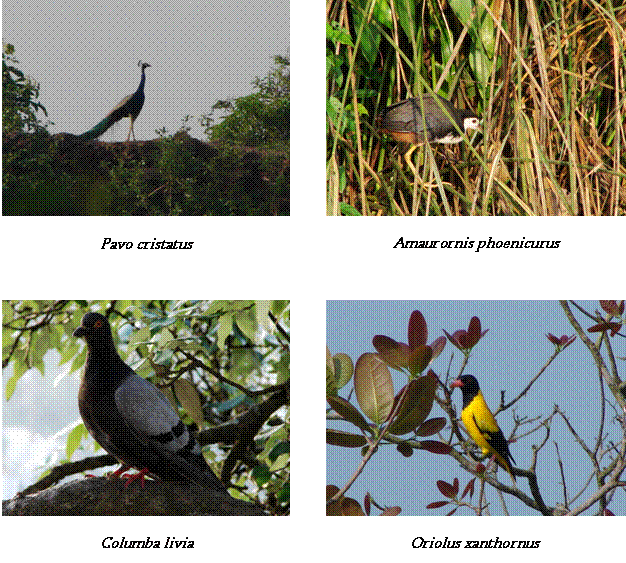
Figure 9: selected bird species from the study region
The region is rich in biodiversity evident from the occurrence of flora and fauna species. This study records 187 species of plants, 59 butterflies, 11 odonates, 6 amphibians, 3 reptiles, 55 birds and 7 species of mammals in a short duration of two days and in a few selected localities. Also many of these taxa are protected under Wildlife Protection Act, 1972, amended 2006. Considering the ecological and biodiversity significance of the region we suggest the following
I. Section 10 of the Constitution (Forty–second Amendment) Act 1976, Article 48 : 48 A Protection and improvement of environment and safeguarding of forests and wildlife – The State shall endeavour to protect and improve the environment and to safeguard the forests and wildlife of the country.
II. Section 11 of the Constitution (Forty–second Amendment) Act 1976, Article 51 A, Part V-A: 51 A Fundamental Duties – It shall be the duty of every citizen of India - (g) To protect and improve the natural environment including forests, lakes, rivers and wildlife, and to have compassion for living creatures.
Primary goals of conservation of the ecosystems are to:
III. Forest policy 1998 -
IV: Forest (Conservation) Act, 1980
To check indiscriminate diversion of forestland. Under this legislation, approval of the Central Government is required before any forestland (noted as such in Government records) is diverted for non-forestry purposes.
V. The Wild Life (Protection) Act, 1972
This Act provides the protection of wild animals, birds and plants and for matters connected therewith or ancillary or incidental thereto with a view to ensuring the ecological and environmental security of the country. The Act has 11 Chapters and 121 Sections and has categorized animals, birds, and plants in six Schedules. Schedule I lists endangered species of mammals, amphibians, reptiles, birds, crustaceans and insects. For the possession, transportation, translocation, etc., of these species permission from the Government of India is needed. Penalties for contravention of the Act for Schedule I species are very stringent. The Act provides for the setting of protected areas such as national parks, wildlife sanctuaries, conservation reserves and community reserves. It also has provisions for control of trade and taxidermy in wildlife and for the setting of wildlife advisory boards to advise Central and State Governments.
VI. The Biological Diversity Act, 2002
The Act has a reference to the United Nations Convention on Biological Diversity at Rio de Janeiro in 1992, which reaffirmed the sovereign rights of the States over their biological resources. The Act provides for the conservation of biological diversity, sustainable use of its components and fair and equitable sharing of the benefits arising out of the use of biological resources, knowledge and for connected matters.
Specific clause applicable to this region is:
 16 (1) Restriction on activities related to access to biological resources: Biodiversity Authority shall take the steps to restrict or prohibit the request for access to biological resources for the following reasons; namely :-
16 (1) Restriction on activities related to access to biological resources: Biodiversity Authority shall take the steps to restrict or prohibit the request for access to biological resources for the following reasons; namely :-
• activities that will result in adverse environmental impact which may be difficult to control and mitigate;
• the request for access is for any endangered taxa, endemic and rare species;
• the request for access may likely to result in adverse effect on the livelihoods of the local people;
• the request for access may cause genetic erosion or affecting the ecosystem function
VI The Environment (Protection) Act, 1986
This Act provides for the protection and improvement of environment and for matters connected therewith. India participated at the United Nations Conference on the Human Environment held at Stockholm in June 1972 and decided to take appropriate steps for the protection and improvement of environment and the prevention of hazards to human life and health, other living creatures, plants and property.
VII The National Environmental Policy 2006
The principal Objectives of this policy are :
District authorities and elected representatives should take cognizance of prevailing regulation as per the constitution of India and should strive for the conservation of ecologically fragile and sensitive global biodiversity hotspot – the Western Ghats . Taking sincere measures in this direction would be a befitting gift by our generation to the future generation. The governance of the region should encompass the principle of transparency, rationality, accountability, participation, and regulatory independence.
|
*Energy & Wetlands Research GroupCENTRE FOR ECOLOGICAL SCIENCES
|